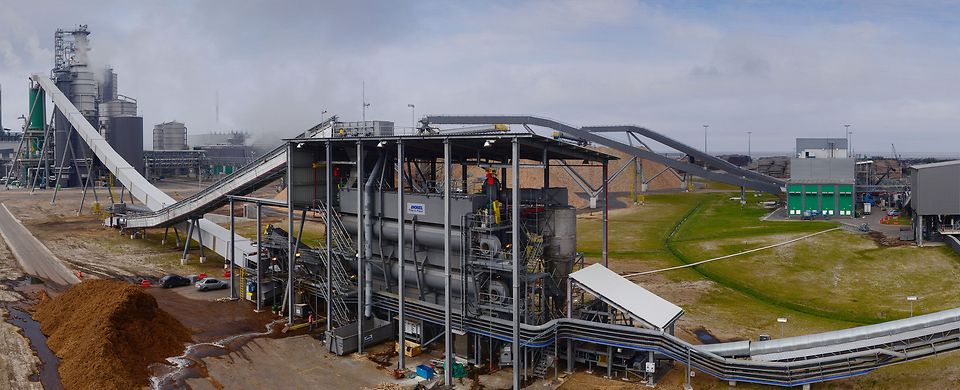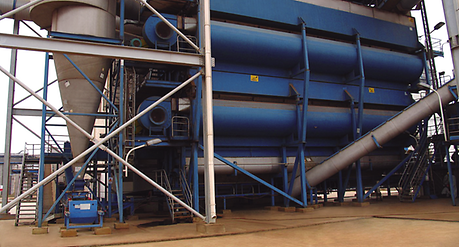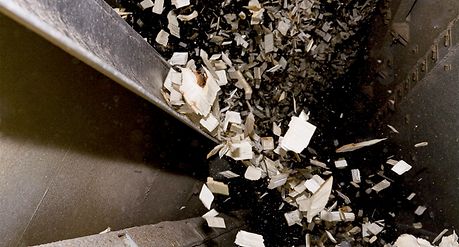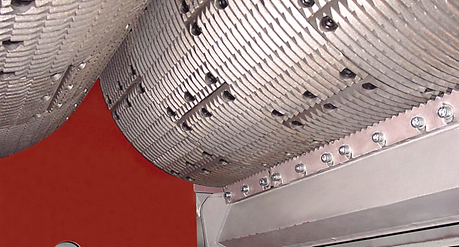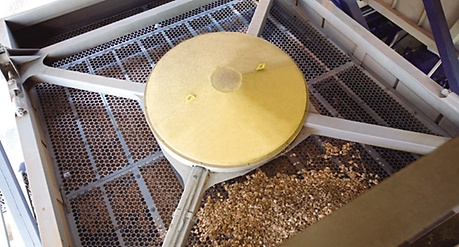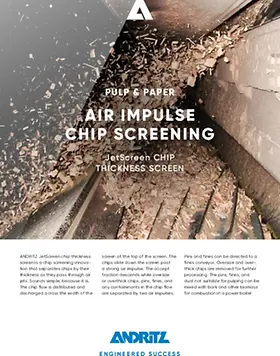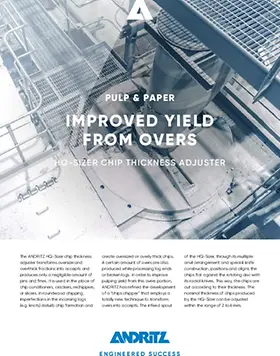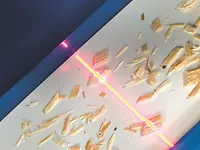JetScreen chip thickness screen
ANDRITZ JetScreen uses air impulses to separate oversize, overthick, pins, fines, and contaminants from the good chips.
Uniquely different screening method
The JetScreen is a completely different screening method with superior flexibility and high capacity. The chip flow is distributed and discharged across the width of the screen at the top of the screen. The chips slide down the screen past a strong air impulse. The accept fraction descends while oversize, overthick, pins, fines, and any contaminants in the chip flow are separated by two air impulses.
When the screening capacity is smaller than 1,000 m3 l/h, the two air impulse stages can be placed alongside each other, rather than one on top of the other, reducing the height of the JetScreen.
Pins and fines can be directed to a fines conveyor. The pins, fines, and dust not suitable for pulping can be mixed with bark and other biomass for combustion in a power boiler.
Oversize and overthick chips are removed for further processing. The oversize and overthick chips can be sent to an HQ-sizer or chip optimizer for treatment. After treatment, the chips are returned to the accept flow. Accept chips passing through the HQ-sizer or chip optimizer remain undisturbed.
Sand, stones, and scrap material are separated for removal.
ANDRITZ JetScreen thickness screen features
- Very clean chips without dust, sand, stones, or scrap
- Very high screening efficiency at high capacity levels
- Separation of chip fractions (size, thickness, and density) with air impulses
- Easy to adjust and control the size of the fractions
- No moving mechanical parts inside the screen
- Very little maintenance required
- Completely closed and dust-free
OPTI chip thickness screen
ANDRITZ OPTI screen delivers excellent screening efficiency at high capacities and superior screening of oversize/overthick chips.
Non-plugging, self-cleaning design
In the OPTI thickness screen, the chip flow is distributed and discharged by a feed conveyor across the entire width of the screen at the top of the machine.
In smaller capacity models, pocket rolls to screen out fines are mounted at the beginning of the thickness screen. In larger capacity screens, a pocket roll fines screen is mounted under the OPTI screen.
Accepts from the OPTI screen fall onto a conveyor, which transports them to chip storage or to a digester.
Fines and some of the pins are transported by a fines conveyor to be mixed with bark and other biomass for combustion in a power boiler.
Oversize and overthick chips are removed for further processing. The oversize and overthick chips can be sent to an HQ-sizer or chip optimizer for treatment. After treatment, the accept chips are mixed with accepts from the OPTI screen.
Two movable gates inside the screen adjust and control the amount of pins, fines, overthick, and oversize fractions separated.
ANDRITZ OPTI thickness screen features
- Very high thickness screening efficiency at all capacities (separation is based on thickness of the chip fractions)
- Superior separation of overthick and oversize chips
- Excellent separation of the accept chips
- Non-plugging, self-cleaning construction
- Adjustable
- Very little maintenance required
- Dynamic loads minimized
ANDRITZ pocket roll fines screen features
- Three-dimensional separation of fines
- Accurate and high separation performance
- Non-plugging, self-cleaning construction
- Adjustable
CS gyratory chip screen
ANDRITZ CS gyratory chip screen has proven to be the most reliable equipment in the market.
Well-proven, reliable screening technology
The ANDRITZ CS chip screen is a gyratory type design suspended from four steel ropes. An electric drive with a single shaft and counterweights in the middle of the screen produces a freely vibrating and adjustable, horizontal circular motion to screen chips. This screen model was originally introduced in 1980 and has been proven to be the most reliable screen in the market.
Chips are fed through a wide infeed chute which distributes chips over the entire surface of the upper screening deck. Oversized chips and slivers flow over the top deck to a rejects chute, which collects them for further treatment. Chip accepts successively drop to the middle and lower screening decks, where they are discharged to storage or the pulping process. Fines pass through all the decks and are collected at the bottom of the screen, which has a central discharge opening.
The frame construction of the CS gyratory screen is very rugged and simple, made of rectangular and square tubes. Standard screening decks are made of mild steel. For abrasive conditions, the screen decks can be supplied in stainless steel. The screening decks are bolted to the frame.
There are four different models of the CS screen, based on capacity required. The standard CS screen has three screening decks. A fourth screening deck is added when very efficient pin chip recovery is required, or when chips are being classified to separate thickness screens.
The CS screen can be equipped with a protective dust covering which covers infeed and discharge chutes and a partial or complete cover for the top of the screen.
Servicing is accomplished by opening the screen rear panels, which expose the entire interior of the screen. The two drive shaft bearings are piped for automatic lubrication by a simple, central lubricating unit.
ANDRITZ CS gyratory chip screen features
- Large capacity range: 3 or 4 screening decks
- Stainless steel screening decks available for abrasive conditions
- Rugged and simple construction
- Effective oversize, overthick, and fines separation
- Self-cleaning due to the amplitude, frequency, and screening deck inclination
- Easy maintenance
SCL gyratory chip screen
ANDRITZ SCL gyratory chip screen is a reliable, proven screen for smaller capacities
Flexible sectional design
The sectional design of the SCL chip screen gives the screens their characteristic six- or eight-sided shape. Each screen plate is light in weight and easy to handle.
The screen is suspended from steel wire ropes. Chips are fed into the center of the screen. The rotating motion of the screen, generated by a rotating counterweight, spreads the chips evenly over the screen plates. The chips reach the screen plates at the point where the plates are widest and have the greatest capacity. As the requirement for capacity reduces, the screen plates become narrower.
An optional third screening deck can be added to reduce the load on the fines deck and improve selectivity. If the chip flow contains a large amount of oversize chips, the screen can be delivered with a coarse screen deck at the top to increase capacity. The outlets for fines and oversize chips can be adjusted to fit the best plant layout.
ANDRITZ SCL gyratory chip screen features
- Screen for small capacities
- Compact design
- Layout-friendly
- Easy maintenance
HQ-Sizer for oversize/overthick chip processing
ANDRITZ HQ-Sizer resizes oversize and overthick chips to uniform acceptable thickness.
High quality and high yield from the oversize chip fraction
Knots in roundwood disturb the chipping process and create oversize fractions. A certain amount of the oversized chips are also produced from log ends and breakage. These oversize or overthick chips are typically removed in the chip screening system and are sent for further processing.
In order to improve the quality and yield of chips from the oversize fraction, ANDRITZ developed a “chip chipper” called the HQ-Sizer that employs a new technique for converting oversize chips into accepts. With its special infeed spout, multiple anvils, and knife arrangement, the HQ-Sizer aligns the incoming chips so that they lie flat against the rotating disc. This allows the chips to be cut to a uniform thickness. The nominal thickness desired can be adjusted by the operator.
The HQ-Sizer allows any accept chips in the incoming feed to pass through the cutting knife basically untouched, since the chips are well-positioned before cutting.
The HQ-Sizer is capable of handling a chip flow that previously required two or more machines, such as chip crackers or chip slicers.
ANDRITZ HQ-Sizer features
- Oversize and overthick fractions efficiently converted into accept chips
- Improved yield and reduced rejects in pulping
- Minimum fines and pins generation
- Minimum mechanical damage to the fibers in chips
- Low operating and maintenance costs
Chip Optimizer for oversize/overthick processing
ANDRITZ Chip Optimizer retains fiber quality by gently bending oversize and overthick chips to acceptable size and thickness.
Specially designed rolls minimize fiber losses
Unlike existing methods of oversize chip treatment, the Chip Optimizer employs a specially designed roll surface that bends the chips gently (reducing pins and fines as well as minimizing fiber losses). The design of the Chip Optimizer has been thoroughly researched and tested.
Chips are not crushed, but bent when they pass between the two horizontal, counter-rotating rolls in the Chip Optimizer. This bending action does not damage the wood fibers and keeps the wood fiber length at a maximum by producing internal cracks along the grain. This contributes to increased cooking liquor penetration.
The rolls are independently driven to ensure smooth start-up, increased starting torque, and mechanical protection against overloading. One roll is fixed and the other is movable so that the nip between the rolls can be adjusted for different chip thicknesses.
Since it has no wear components (e.g. slicer knives and anvils), the Chip Optimizer requires only basic maintenance without costly production shutdowns. Both rolls are covered with bolted segments manufactured from a wear-resistant material. If needed, a special coating can be applied to the segments to increase corrosion resistance.
ANDRITZ Chip Optimizer features
- Gentle bending action produces less fiber damage
- Reduced generation of pins and fines
- Improved impregnation of cooking chemicals
- Improved pulping yield and reduced rejects in pulp
- Minimum service requirements
- Roll segments have long life and are easily replaced
Rechipper for oversize chip processing
ANDRITZ Rechipper processes oversize chip fractions better than drum chippers or shredders.
V-shaped chute and superior chipping geometry
The ANDRITZ Rechipper processes oversize chips into accepted chips with a minimum amount of fines generation. The performance of the Rechipper is well-proven, and far superior to drum chippers or shredders.
The oversize fraction and slivers are gravity-fed to the Rechipper via the infeed spout, where they come into contact with a rotating disc equipped with radially mounted knives. The knives cut the oversize chips to the required length. The clearance between the knives and the bed knife is easily adjusted by an operator to ensure high chip quality.
The excellent performance of the Rechipper is aided by the V-shaped chute and its chipping geometry. This combination provides effective guidance and stabilizing of the oversize chips prior to and during chipping.
ANDRITZ Rechipper features
- High chip quality compared to drum type rechippers and shredders
- High capacity
- Excellent reliability
- Easy operation
- Easily adjustable nominal chip length
